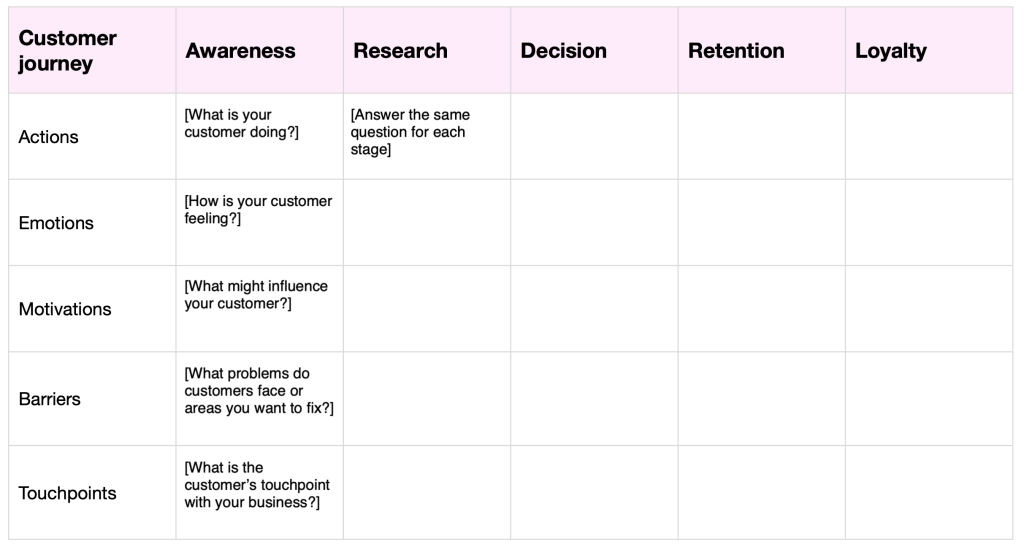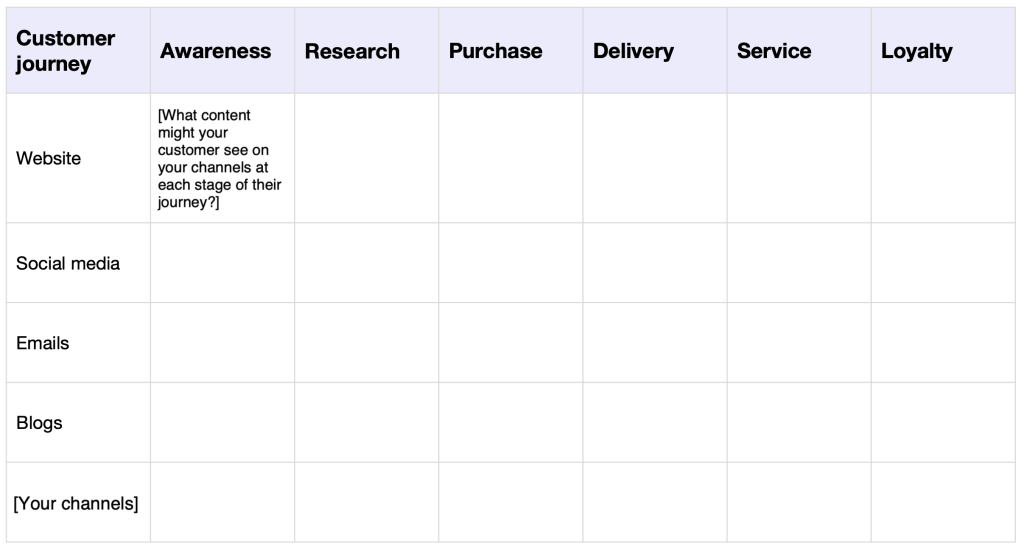Who are your customers? And what makes them buy your product or service? One of the keys to marketing success is building a customer journey map. This helps you understand how people are engaging with your business – and what might push them to spend their hard-earned cash with you.
Approximately 85 per cent of orders started on mobile devices in the UK weren’t completed from April to June 2023, according to Statistica. So, if you can keep customers thinking about your business after they’ve initially put something in their basket – even if they go away to do something else – then you’re more likely to make a sale.
The customer journey may sound like a complex marketing strategy reserved for bigger businesses, but it can be useful at any stage. Whether you’re a startup or an established brand, creating a customer journey map is all about getting to know the people behind your sales numbers.
Keep reading to learn how to map the customer journey, questions you need to ask, and the five stages every customer goes through – whatever your business.
We’ll cover:
- what a customer journey map is
- why create one for your small business
- how to create a customer journey map
- an example customer journey map for a retail business
You can also download your own customer journey map template.
What is a customer journey map?
A customer journey is the interactions a customer has with your company. And a customer journey map is a visual representation of this journey, designed to help you plan your marketing around different stages.
Anything your potential customers see about your business while they’re making a decision to buy something is known as a customer touchpoint. For example:
- blogs
- social media
- banner ads
- website
- emails
- online reviews
- videos
Some elements you can’t control but other things you can. It’s your job to send the right messages out at the right time – and keep your customers happy along the way.
Why should you create a customer journey map for your small business?
Knowing who your customers are and what’s important to them can help inform your marketing strategy. A customer journey map can help you:
- boost your sales
- improve customer experience (and increase repeat business)
- answer problems your customers have
- tailor your messaging and highlight where you have gaps in your content
- predict customer behaviour and common trends
How to create a customer journey map
There are five stages in a typical customer journey:
- Awareness
- Research
- Decision
- Retention
- Loyalty
For each stage you’ll need to consider who your customers are, what emotions they might be feeling, and what messages they’re getting from your business.
An NPS score or customer survey can help you understand how your current customers feel about your business. Research the challenges they have and try to solve them by answering common questions on your social media or making your website more mobile-friendly.
This can all help you create a ‘buyer persona’ – an outline of who your typical customer is in terms of interests, attributes, and what influences them.
Conducting business market research and competitor analysis is also useful to understand how similar companies in your industry are connecting with their customers.
1. Awareness
The awareness stage is when a customer has just become aware of a problem they need to solve. For example, they’ve moved house and need to book a new window cleaning service or they need a new pair of shoes.
A website created with search engine optimisation in mind can help you here (we have a guide to some of the free SEO tools out there to help you).
Touchpoints: Website, social media, word of mouth, advertising.
2. Research
The next stage is when a customer is looking for more information, comparing alternatives, and reading more about what you’re offering. The time someone spends in the research phase depends on the product or service. While clothing or handmade products might attract spontaneous buyers, more expensive items might need a longer time to research.
Touchpoints: Website (about pages), blogs (product comparisons, customer stories), online reviews (Google/Trustpilot/Checkatrade), social media.
3. Decision
Great news – a customer has decided they want to buy your product or service. This stage is important as a bad buying experience can lead people to abandon their decision. They might buy online or, if you have a physical shop, they might decide to visit your shop and speak to a salesperson.
Touchpoints: Website (checkout, pricing pages), social media (special offers), emails.
4. Retention
Also known as engagement, the retention stage is how the customer feels once they’ve started using your product or service. They might need help getting set up with your service or want to share feedback.
How you manage customer complaints is an important part of the retention process. You can also share helpful guides on your blog to answer common questions.
Touchpoints: Website, emails (thank you for your order, loyalty discounts, reminder to renew or buy again), delivery experience (courier notifications, packaging), social media.
5. Loyalty
The loyalty stage is also sometimes known as advocacy. If a customer has had a positive experience with your business then they’re likely to buy from you again or recommend you to a friend.
Keep them engaged by encouraging them to write a review or rewarding them with loyalty discounts and special offers. Having a simple website can help create a positive customer experience.
Touchpoints: Website, emails (reminders to buy again, review a product, or refer a friend links), social media.

Example customer journey map for businesses
Customer journey map template
Download your free customer journey map template to get started for your business. It includes space for you to note down what your customer might be feeling and what messages and content you might want to share at different stages.
Customer journey map example for a retail business
Let’s say you run an Etsy shop or have your own online clothing brand, here’s a customer journey map example:
Awareness – A customer is thinking about buying a handmade gift for their friend’s birthday and they hear about your business. This could be through a social media post or a link to your website.
Research – They’re researching products by browsing your website and reading reviews. If you have blog articles comparing different products or highlighting your sustainable brand mission, people might read these as part of their research too.
Purchase – Your customer has now decided to buy your product, adds the item to their basket, and goes through to the checkout. A simple buying process and form help create a positive customer experience.
Delivery – The gift is ordered and they’re waiting for the parcel to arrive. You send an automated email thanking them for buying the item, which includes links to blogs about how they can make the most out of the product. You choose sustainable packaging and include a personalised thank you note in the box, along with a card prompting them to write a review.
Service – The service stage can be added if you want to focus on how customers feel if they want to return something or need to get in touch with you about a problem. You can improve your website to make the returns process clear and be responsive and empathic when replying to customer emails and social media enquiries.
Loyalty – You send an automated email to the customer asking them to review the product they bought. You also include a code so they can get a discount next time if they refer a friend. They’ve signed up to email newsletters so you regularly send them updates about new products and industry trends.
Read more about how to improve the customer experience and why it’s important in our guide.

Example customer journey map for a retail business
Are you creating a customer journey map for your small business? Let us know how you get on in the comments.
More guide for small businesses
Ready to set up your cover?
As one of the UK’s biggest business insurance providers, we specialise in public liability insurance and protect more trades than anybody else. Why not take a look now and build a quick, tailored quote?
Photograph: Nina/peopleimages.com/stock.adobe.com
